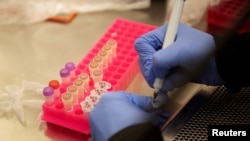When the COVID-19 virus attacks, it turns the patient's own cells into virus factories.
It starts at the surface of the cell, when the virus latches on to a protein that normally helps regulate the patient's blood pressure. The cell unwittingly brings the virus inside, where the attacker unloads its cargo: instructions for making more virus.
Having no equipment of its own, the virus commandeers the cell's machinery to make copies of its genetic code, manufacture more virus shells and deliver packaged germs to the cell surface, where they go on to infect more cells.
Drugs already on pharmacists' shelves act on various parts of that machinery. Though they may not be intended as antiviral drugs, in the scramble to treat the rising toll of COVID-19 infections, scientists are hoping that these existing drugs might offer some help.
"We don't have the luxury of a five-year drug discovery program. We need the agents now," said Warner Greene, a physician and researcher at the Gladstone Institute of Virology and Immunology.
The search has turned up some oddball candidates. Anti-cancer drugs, heart disease medications, a drug against schizophrenia and a treatment for Parkinson's disease have all turned up as possibilities. Testing is already under way for chloroquine, an antimalarial drug.
Mysterious ways
Despite all the science behind drug development, scientists often don't know exactly how medications work.
"In a lot of cases, we don't know all their mechanisms of action," said University of Manitoba virologist Jason Kindrachuk. "Sometimes we actually find that there are effects that we didn't recognize initially."
These therapies also may prove useful because drugs frequently have multiple effects. Our cells often use the same machinery to do different jobs, Kindrachuk said, and a drug that acts on one part of the machinery may produce more than one result.
Sometimes the results are unwanted side effects. But sometimes they offer opportunities to treat entirely different conditions.
When bald men taking the blood pressure medication minoxidil grew hair, the drug was repurposed as the blockbuster hair-growth product Rogaine.
Viagra was originally developed to treat chest pains from heart disease. Its impacts on erectile dysfunction were an unexpected — and lucrative — surprise.
Better together
But a drug designed for something else may not work as well against a virus.
"I do think that we might find a drug that's moderately effective, or several drugs that are moderately effective," Greene said. "And then the question is, what if you put those two moderately effective drugs together? Can they synergize and can you get a very potent antiviral? That's our plan."
His group is screening thousands of drugs to see if they work against the virus in a test tube. He hopes to have results in two or three months. Several teams are pursuing similar strategies, using robots to run large numbers of tests at once.
Other scientists are working to unravel how the virus interacts with the different processes happening inside human cells, and looking for drugs that act on those processes.
It's very early-stage research. Any drug that looks good in these tests would need to be tested on animals, and then on small groups of people, to be sure it does not do more harm than good.
Greene cautions there is a long way to go.
"It's a first step," he said. "There's lots of false leads there. But there are leads."








